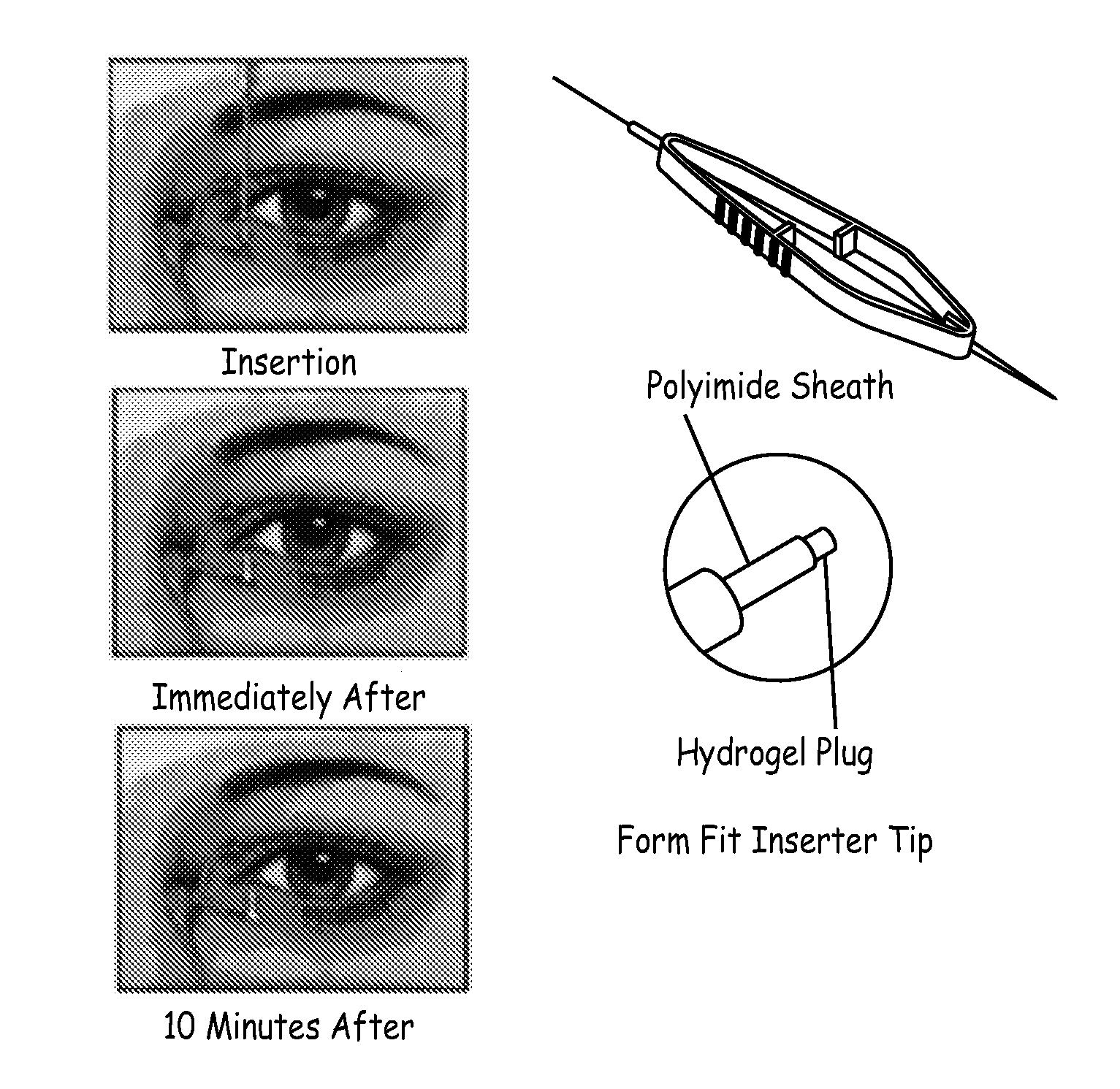Drug delivery through hydrogel plugs
a technology of hydrogel plugs and drops, which is applied in the direction of prosthesis, antibacterial agents, drug compositions, etc., can solve the problems of inefficient utilization of drugs, inability to get drops into the eye, waste, etc., and achieves high patient compliance, enhanced safety, and efficiency.
- Summary
- Abstract
- Description
- Claims
- Application Information
AI Technical Summary
Benefits of technology
Problems solved by technology
Method used
Image
Examples
example 1
Organic-Solvent-Based Manufacture of Pre-Formed Device
[0183]A first protocol based on drugs miscible in an organic solvent was developed as follows. 90 mg of 8-armed 15,000 molecular weight polyethylene glycol with succinimidyl glutarate at each arm terminus (8a15K PEG SG) was dissolved with 6.7 mg of trilysine in 329.1 mg of methanol (MeOH) containing 24.2 mg of drug substance. This correlates to a 20% concentration of polymer in the MeOH solution, and a 20% w / w drug loading in the final dried punctum plug.
[0184]The solution is drawn into silastic tubing with a known diameter, closed with a clip, and held vertical until the crosslinking reaction is complete. The clips are removed, and the gel filled tubes placed into a vacuum chamber. The gels are dried for 24 hours at 100 mTorr and removed the following day. The dried plugs are removed from the silastic tubing, and cut to size; the optimal length ranges between 2.0 and 4.0 mm.
[0185]This method may be used for loading of non-water ...
example 2
Methanol-Based Manufacture of Pre-Formed Device
[0186]90 mg of 8a15K PEG SG was dissolved with 6.7 mg of trilysine in 353.3 mg of MeOH. This correlates to a 20% concentration of polymer in the MeOH solution. The solution is drawn into silastic tubing with a known diameter, closed with a clip, and remains vertical until the crosslinking reaction is complete. The clips are removed, and the gel filled tubes placed into a vacuum chamber. The gels are dried for 24 hours at 100 mTorr and removed the following day. The dried plugs are removed from the silastic tubing, and cut to size; the optimal length ranges between 2.0 and 4.0 mm.
[0187]The pre-formed devices are added to a solvent such as MeOH, known to swell cross-linked ITX hydrogels. The MeOH contains dissolved drugs at high concentrations. Plugs are allowed to swell with organic drug solution, causing some drug to permeate into the hydrogel matrix. Gels are removed, and either dried again as above, or placed into a non-solvent such a...
example 3
Aqueous-Based Manufacture of Pre-Formed Device
[0189]90 mg of 8a15K PEG SG was dissolved with 6.7 mg of trilysine in 329.1 mg of water containing 24.2 mg of a suspension of drug. This correlates to a 20% concentration of polymer in the MeOH solution, and a 20% w / w drug loading in the final dried punctum plug. The drug suspension may be, e.g., insoluble drug particles or a suspension of encapsulated drug formulation.
[0190]The solution is drawn into silastic tubing with a known diameter, closed with a clip, and held vertical until the crosslinking reaction is complete. The clips are removed, and the gel filled tubes placed into a vacuum chamber. The gels are dried for 24 hours at 100 mTorr and removed the following day. The dried plugs are removed from the silastic tubing, and cut to size; the optimal length ranges between 2.0 and 4.0 mm.
[0191]This method is suitable for, e.g., loading of drugs encapsulated in other polymer systems. The aqueous based manufacture may be used to avoid ex...
PUM
| Property | Measurement | Unit |
|---|---|---|
| width | aaaaa | aaaaa |
| size distribution | aaaaa | aaaaa |
| diameter | aaaaa | aaaaa |
Abstract
Description
Claims
Application Information
 Login to View More
Login to View More - R&D
- Intellectual Property
- Life Sciences
- Materials
- Tech Scout
- Unparalleled Data Quality
- Higher Quality Content
- 60% Fewer Hallucinations
Browse by: Latest US Patents, China's latest patents, Technical Efficacy Thesaurus, Application Domain, Technology Topic, Popular Technical Reports.
© 2025 PatSnap. All rights reserved.Legal|Privacy policy|Modern Slavery Act Transparency Statement|Sitemap|About US| Contact US: help@patsnap.com



